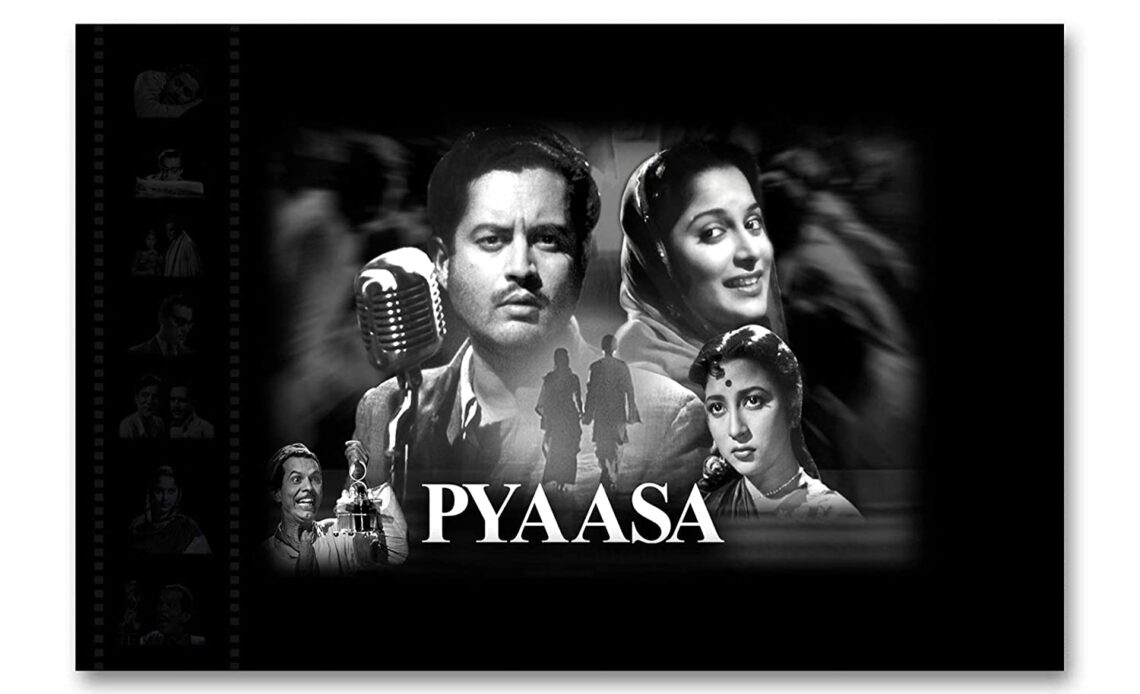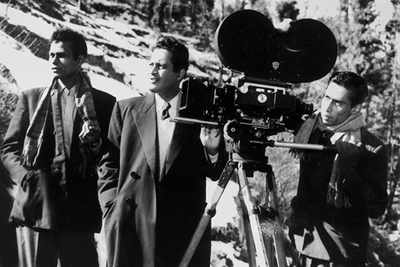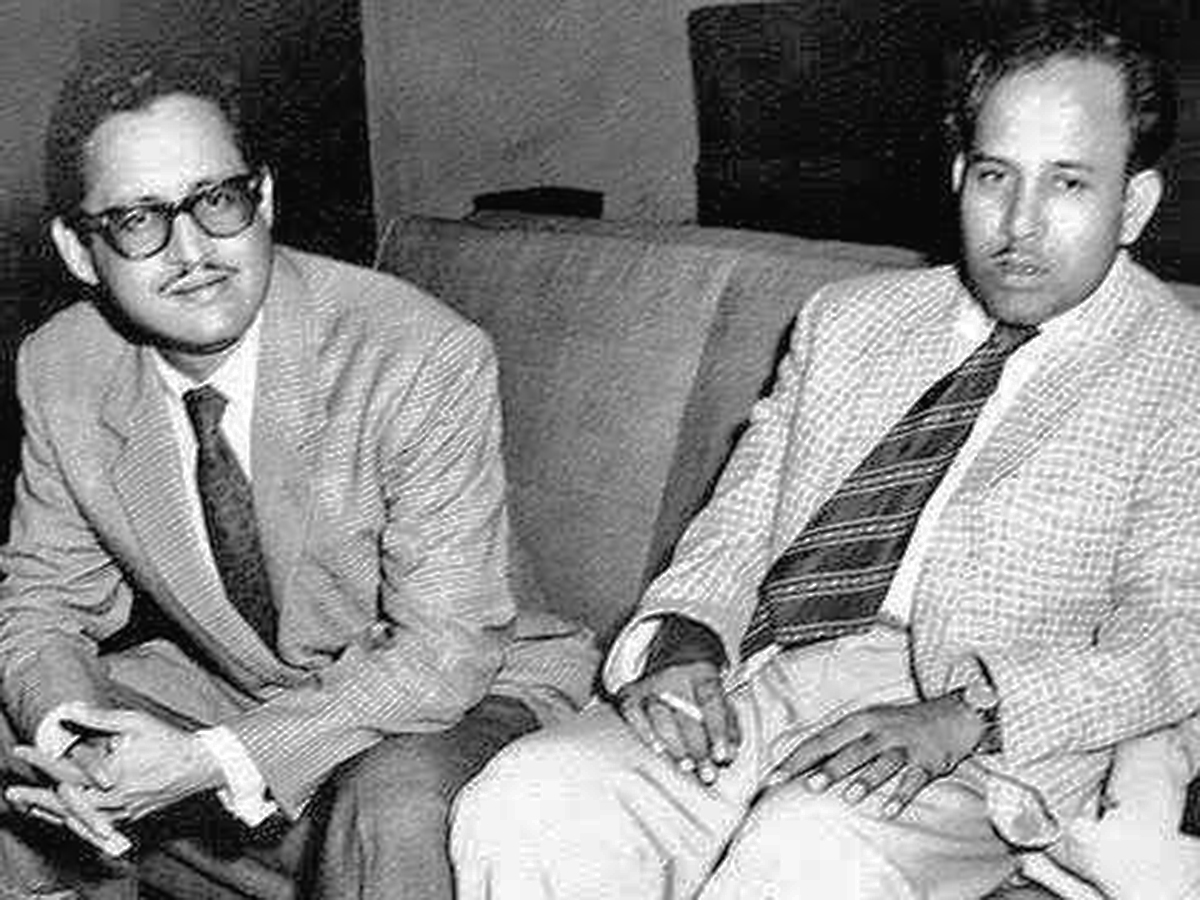
Today, the movie that I am going to talk about has been named in the 100 BEST movies of All time by TIME Magazine in 2005. No, it is none of the names that are coming to your mind. The movie that I am talking about is a classic from 1957…PYAASA. The main power of this film is its timeless nature, as it is as relevant today as it was back in 1957. In short, the movie questions the very meaning of life and the title very aptly fits into the story and symbolism of the movie. The movie was written and directed by the legendary Guru Dutt, who also played the role of the protagonist in the movie. So, come on let’s explore what makes this movie such a timeless classic.
The Idea of the Movie
The core story of Pyaasa was based on the story ‘Kashmakash’ written by Gurudutt only, at the age of 22 based on the struggling life of Guru Dutt only. Being from Almora, Guru Dutt to the Dance and Choreography Academy of Uday Shankar. He was thrown out of the academy because he got into a relationship with the leading lady. After that, he worked as a telephone operator and was fired from there as well. After this, he started working in Prabhat Films, a job that he got because of his brother. Now, it was during these struggling days, that Guru Dutt wrote the story ‘Kashmakash’. Initially, the title was thought as ‘Pyaas’, but Guru Dutt found ‘Pyaasa’ more apt for the meaning.

Pic: Guru Dutt from a still in Pyaasa
A Still Relevant PLOT
The protagonist named VIJAY is an idealist and a struggling writer, who writes deep poems based on real life. But, unfortunately, no one values his work and the world treats both him as well as his work as trash. Even his own brothers don’t consider him anything and want to get rid of him, just because he is unemployed. The woman he loves during his college days, although does love him, but marries someone else (a rich man), just because Vijay was poor. All in all, there was only one reason behind Vijay’s condition, the fact that Vijay wanted to live life on his own terms. He then meets Gulabo, who is a prostitute, during his bad days. They unknowingly start liking each other, without expressing it.
After being fed up, one day, he decides that it’s enough he should end his life. He tries to kill himself, but somehow he is saved by his friend. But, the news comes out that Vijay has died by suicide. Once he is dead, the paradox of life unfolds, as all his verses are released and the copies suddenly create euphoria in the market and huge paychecks start coming onto his name. But, the news comes out that he has died. After his death, Now, one day, he returns back. So, just to get all the money his brothers refuse to recognize him initially. But as soon as they come to know that if they recognize him, it will be a better ‘offer’, they recognize him all of a sudden.
This leaves Vijay completely distraught. He thinks that when he was alive no one paid any heed to him, and now after his rumoured death, people are recognizing his work. Even when he is coming back alive, people only have monetary interests in him. He finally decides to leave this greedy world and goes very far away somewhere. At last, Gulabo too asks to join him, wherever he goes, and they go together.
जब हम चले तो साया भी अपना न साथ दे; जब तुम चलो तो ज़मीन चले, आसमान चले;
जब हम रुके तो साथ रुके शाम-ए-बेकसी; जब तुम रुको बहार रुके, चांदनी रुके
One of the FINEST Cinematography
Guru Dutt was very much inspired by the concept of Visual Storytelling, and that is clearly visible in Pyaasa. Throughout the film, we find a very layered piece of storytelling. There are multiple uses of metaphors, symbolism and analogy in the movie. The cinematography is very advanced level if we compare it with the other movies of that time.
There is a scene when a distraught Vijay is drinking in a bar. The bar dancer is dancing, while her child is crying and she wants to go to the child. But, first, her employer and then a customer in the bar as well, stops her from going. The distraught Vijay gets extremely heartbroken looking at this. At this point, the ‘Director’ Guru Dutt takes a great close-up shot of the ‘Actor’ Guru Dutt, making the audience feel the raw emotion of the scene.

Pic: The Iconic ‘Jesus Christ’ scene from Pyaasa
Another great scene is the point when a broken Guru Dutt is going down the stairs. He is entering a dark world of hungry and greedy people, who are laughing maniacally. In that scene, light is falling on Vijay while all others are dark. It represents that Vijay is the only person with a pure heart, and the idealist in him still expects that everything will be alright one day.
But, the most standout scene in Pyaasa is the Jesus Christ Pose. Just like the world mistreated Jesus Christ while he was alive, and it was only after he was crucified, that the world realized his value. Similarly, the story of Vijay too unfolds. The world doesn’t realise his potential, and only after the world ‘thought’ that he is dead, do people start valuing him. Similarly, just like Jesus Christ came back at Easter to make the world realize the truth, Vijay too comes back and then leaves the world once and for all. The Jesus Christ pose comes many times in the movie to symbolize the tragic life.
The SADDEST Music Album
Pyaasa’s music was a superhit, it is one of the SADDEST albums ever. All songs have been made by Mohammad Rafi, Hemant Kumar and Geeta Dutt. The lyrics were written by Sahir Ludhianvi and SD Burman gave the music. The movie is one of the greatest jewels in Sahir’s crown. For a fact, the film was also loosely inspired by the ‘incomplete relationship’ of Sahir Ludhianvi and Amrita Pritam. The level of the music can be understood by the fact that Jawaharlal Nehru had tears in his eyes after he listened to the song ‘Naaz Hai Jinhe Hind Par’.
Also, the ‘Sar Jo Tera Chakraye’ song was composed by Rahul Dev Burman, the son of Sachin Dev Burman. It was inspired by the English film ‘Harry Black’. But, Rahul had composed the music with so much diligence that even the original song makers couldn’t recognize it. SD Burman used to allow his son to make some exciting kinds of songs. After he had made them, he would fine-tune them and release them. Neither does he give credit to his son, nor his son wants it. Later, RD Burman would end up making his own fate as a singer.
Also Read: My Amazing Blog on the GOAT Movie GODFATHER
Release and Reception
Pyaasa movie was made on a budget of around 30 lakhs and it grossed 1.5 crores at the box office and around 3 crores worldwide. Though it opened quite low, still regained its track and eventually was a Superhit. The movie was very well received overseas as well, such as in Germany, Russia, Japan, and Singapore. France also kept its special premiere in 1984. But, contrarily in India, the movie didn’t even get any nominations, forget the awards.
The whole shooting was completed in 16 days and the ‘tape’ of the movie, that came out was 16,598 feet long. The film had to be remastered in the studio as the original print had many marks and blurry patches. Ultra Movies did a great job by restoring the print of the movie. For cleaning each and every frame, 45 experts had to work for 4 hours on 2,00,000 frames. Even the music was restored.

Pic: Pyaasa had to remastered for better quality
Guru Dutt…the ace Director
The song Jane Kya Tune Kahi had to be shot at night, but Waheeda used to sleep early. So, every time, for shooting water was thrown at her face after which she used to do the shot. Interestingly, Waheeda hadn’t heard the word ‘Streetwalker’ before, so she wasn’t able to do the scene, But, Guru Dutt was a brilliant director as well, he knew what exactly he needs to say to an actor. Waheeda too said that she was just following his instructions, and the scenes were coming out greatly.
Also, when she was not able to bring up one particular scene as Guru Dutt wanted her to, He told her to think as if she is waiting for her ‘father’ on the roof. The next shot was just perfect. In another scene, where Gulabo unknowingly rudely sends off Vijay, she had to come down the stairs after realizing her mistake. Though she remembered the dialogues, she used to blow out after running down the stairs and couldn’t say the dialogues properly. When Guru Dutt asked about the dialogue, Waheeda’s mother told him the problem. So, Dutt brought a ‘cut’ between the two shots and the scene was done perfectly.

Pic: Guru Dutt at the sets of Pyaasa
International Acclaim
As I already said about Time magazine naming Pyaasa in the 100 Best Movies of all time. Later, the same platform also named it in the list of Best Romantic movies of all time. Another platform ‘Test of Time’ selected it in the Top 25 Influential Movies. In 2002, Critics and Directors Polls of the ‘Sound and Site’ platform ranked Pyaasa at 160th position in Greatest films of all time. The same platform also rated its music, as the Best Music in the World.
Also, if we look within India, this is the favourite movie of Superstar Aamir Khan. Now, I don’t give a damn about the illiterate and filthy Boycott Gang, but I rate the choice of Mr Perfectionist very highly. Satyajit Ray, India’s GREATEST ever Director said “Great sense of rhythm and fluidity of the Camera” for the movie, now what else is required to decorate your head with pride.
“गर्मी चाहे मौसम की हो या दौलत की, सिर्फ गधे ही मगन रहते हैं उसमे!”
The Significance of KOTHA in the Movie
Guru Dutt also had to visit the ‘Kotha’ and Abrar took him there. He saw a 7month-pregnant woman dancing and people laughing, Guru Dutt was heartbroken after this. After this, he decided to make the ‘Kotha’ an important part of the film. Initially, Gurudutt wanted to shoot Pyaasa in the real red-light area in Kolkata, but some miscreants were creating a nuisance on the sets and also causing damage to it. So, Guru Ditt had to recreate its set in Mumbai only.
“मैं दूर जा रहा हूँ…जहाँ से मुझे फिर दूर ना जाना पड़े!”
Guru Dutt and Abrar Alvi
Guru Dutt’s fellow writer Abrar Alvi, with whom he wrote most of his great works. They used to write the scripts after long and deep conversations. Dutt wanted to make Pyaasa for a very long, but Abrar stopped him every time asking him to first establish himself as a director. But once Dutt made the successful Mr and Mrs 55, he straightaway told Abrar that he is making the movie. Also, the two were on conflicting sides regarding the climax of Pyaasa. While Alvi wanted the protagonist to accept whatever the world offers him in the end, Gurudutt was tempted to make the protagonist leave everything.

The ‘Rejected’ Cast
The role of the protagonist in Pyaasa was tailor-made for the Tragedy King of Bollywood…Dilip Kumar. Initially, he did give his nod, but after he didn’t show up on sets despite being called multiple times, Guru Dutt himself entered into the grooves of the character. Dilip Kumar later said that he regretted his decision, and he let go of the movie as he had done such roles before.
Initially, Guru Dutt wanted to cast big names Madhubala and Nargis as the two leading ladies. But, rather interestingly, the two couldn’t decide which of the two roles they should play. Finally, Guru Dutt decided to move on and cast two fresh and lesser-known faces…Mala Sinha and Waheeda Rehman. So, we can see that the cast that actually nailed the movie, was not the initial cast by a mile.

Johny Walker as Abdul Sattar in Pyaasa
How we got ABDUL SATTAR
Guru Dutt and Johny Walker were very close friends. As soon as Guru Dutt picked up a script, he used to start thinking about the role for Johny. This time as well, he gave him the role of Shyam. But, for making him understand the Kolkata-based role, he took him to Kolkata. There, both were sitting at the ‘Paani-Puri’ shop. Then he saw a man doing ‘Champi Tel Maalish’. Just, then Guru Dutt gave him the role of Abdul, the man behind “Maalish…Tel Maalish…Champi”…!!!!!
“अपनी शायरी से कौम-ओ-वतन को तरक्की देना… खोखली मोहब्बत के ढोल पीटने से कहीं बेहतर है।”
The Reel and Real Gulabo
Abraar Alvi and Guru Dutt were great friends. Abrar used to write the story along with Guru Dutt. Now, the whole character of Gulabo is based on a real-life episode from Abrar’s life. One day, two of his friends took him to a ‘Kotha’ and they forcibly decided that each of them would pick one girl and take them to the sea beach. While his friends picked 15-16 years old girls, Abrar surprisingly picked a middle-aged woman (28-29 years) named…Gulabo. While others would go to the beach, Abrar would just be sitting with her in the car having deep conversations with Gulabo.
Even after that day, Abrar used to go to meet her. They had established a bond, which can’t be defined ‘technically’. Unfortunately, the story couldn’t go long, as Gulabo caught T.B. and passed away. But, she was always there in Abrar’s mind, so much so that the whole character of Gulabo came from her. Some of reel life Gulabpo’s lines in the movie are exactly what Gulabo had said to Abrar. The sexless interactions with a sex worker birthed a character in an immortal movie.

Pic: Guru Dutt and Waheeda Rahman
Hiccups in Guru Dutt’s Personal Life
Geeta Dutt, also the singer in the movie was Guru Dutt’s wife, but there were too many ups and downs in their relationship. And while shooting Pyaasa, Waheeda Rahman also entered Guru Dutt’s life. He even married her by himself converting to Islam. After this, Geeta Dutt went to Kashmir and started living with a Pakistani guy. Guru Dutt was both sad and angry at this. So, he broke his relationship with Waheeda and tried to reunite with Geeta Dutt. Though the two did come together, they again separated after a few years. After this, Geeta started drinking heavily and that eventually led to her death.
Also Read: My Amazing Blog on the timeless classic of Charlie Chaplin…THE GREAT DICTATOR
A Timeless Classic of the Highest Order
So, we saw how much effort and emotions went into the making of Pyaasa. Sadly, just after this movie, Guru Dutt came up with another classic KAAGAZ KE PHOOL, the movie tanked badly as the public couldn’t understand it. That failure drove Guru Dutt into depression, and he never made a movie again. His personal life already had too many hiccups as we saw. All this lead to Guru Dutt dying of a ‘suspected’ suicide because of a drug overdose. Though he has left the world, but his story is still unfinished and his art lives on even today through his classics. It’s just phenomenal how Guru Dutt was able to come up with something that Bollywood has not been able to match even till now. We should really be proud of this movie and should actually celebrate this gem of Indian cinema. What the movie achieved then, hasn’t been matched by Bollywood even till now, so it’s an art of such high order. I would like to end the blog with one of the greatest monologues in the history of cinema.
मुझे किसी इंसान से कोई शिकायत नहीं…
मुझे शिकायत है समाज के उस ढाँचे से, जो इंसान से उसकी इंसानियत छीन लेता है, मतलब के लिए अपने भाई को बेगाना बनाता है, दोस्त को दुशमन बनाता है…
मुझे शिकायत है उस तहज़ीब से, उस संस्कृति से… जहाँ मुर्दों को पूजा जाता है और जिंदा इंसान को पैरों तले रौंदा जाता है…
जहाँ किसी के दुःख-दर्द में दो आँसू बहाना बुज़दिली समझा जाता है, झुक के मिलना एक कमजोरी समझा जाता है…
ऐसे माहौल में मुझे कभी शांति नहीं मिलेगी, मीना! कभी शांति नहीं मिलेगी, इसलिए मैं दूर जा रहा हूँ!”

